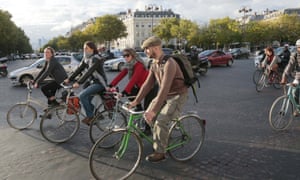Amid the discussions about green energy and carbon capture, it should be remembered that a switch to two wheels could significantly cut emissions

People ride a bike for all sorts of reasons: they’re fun; they keep you fit; in congested cities they have an amazing ability to deliver you to your destination on time. But what about saving the planet?
That’s a tricky one. While cyclists face occasional taunts about being smug, self-righteous eco-warriors, in truth environmental considerations tend to be lower down on their lists of reasons to ride. But for governments it should be a different matter altogether.
As the great and good gather in Paris for climate change talks, it’s time to consider what role the humble bike can play in combating global warming. Amid all the talk about the prosperity of developing nations and China’s coal addiction, bikes might seem a bit trivial, and will likely get little mention at the summit. But this is unfair.
Transport is a major contributor to overall greenhouse gas emissions – in most nations the second-biggest element after energy generation. In the EU, road transport alone makes up about 20% of all emissions, and unlike for most other sectors it is still tending to rise.
Obviously, not every single road journey can be made on a bike. But a lot could. Across Europe, half of all car trips are less than three miles, a distance most people could happily cycle in about 20 minutes. The rise of the e-bike means such trips are more possible even for older people, or those living in a hilly area.
So if, hypothetically, every nation set about building a Dutch or Danish style network of bike infrastructure and took other measures to encourage people on to two wheels, what would it do for emissions?
One of the most exhaustive studies was carried out by the European Cycling Federation (ECF) in 2011. This began by trying to compare the average emissions for bikes and e-bikes with other forms of transport, calculating both the environmental cost of manufacture and of use, which for ordinary bikes included extra calories consumed.
Even with an assumption of the average bike weighing a hefty near-20kg, the study came up with an emissions rate for ordinary bikes of 21 grams of CO2e (carbon dioxide equivalent) per kilometre travelled. For e-bikes, the figure was barely more, at 22g/km. In contrast, the emissions for a car were 271g/km per person, and 101g/km for bus passengers.
Advertisement
Overall, the ECF study calculated that if all the EU’s nations achieved Danish levels of cycling this alone would account for between 5% and 11% of the emissions reductions needed to reach the EU’s official 2020 emissions targets, and would be between 57% and 125% of the reduction needed in transport emissions.
A similar study came out last week, from the New York-based Institute for Transportation and Development Policy and the University of California, Davis. This found that even e-bikes can often prove more energy efficient per passenger-kilometre than many rail systems.
It concluded that a not-too-outrageous upshift in global cycling use – from a current 6% or so of all urban passenger miles to 11% in 2030 and 14% in 2050 – would cut overall emissions by 7% (in 2030) and then 11% (in 2050).
To an extent, all this is pretty well known. So, given David Cameron was to tell the opening of the climate summit that he is “serious about decarbonising”, is his government pressing ahead with pro-cycling policies?
No. For all Cameron’s call for a “cycling revolution”, last week’s autumn statement laid out precisely £300m in cycling investment in the five years from 2015/16. That’s £60m a year, or around £1 per person (outside London, where spending is higher), against a Dutch equivalent of about £20. That £300m would get you about a mile-and-a-half of Crossrail, or about two miles of HS2.
In contrast, the Department for Transport announced on Monday the initial phase of what is known as road investment strategy 2, or RIS2, a successor to RIS1, which devoted £15.2bn to road schemes between 2015 and 2020.
Advertisement
Of course, many more people currently drive than cycle, and RIS2 will tackle motorways and trunk roads, not urban streets. But it illustrates a general approach of planning for a road-dominated future, one where transport-based greenhouse gas emissions will, inevitably, remain high.
It’s worth noting that even if everyone suddenly switched to electric cars overnight – unlikely, given they currently make up just over 20,000 of the 2.2m UK new car sales a year – the emissions involved in making them, and their extra weight, would still make them greatly less efficient than bikes.
It’s one of the curious paradoxes of bikes in the modern world, that this largely low-tech device – if you exclude e-bikes the fundamentals have stayed broadly similar for 130 years – is so beautifully suited as a solution to the very modern problem of global warming. And yet so little is being done.
It speaks eloquently of a failure of imagination, of ambition, of will, of vision among the politicians gathered in Paris. And that doesn’t fill me with optimism about the talks.

